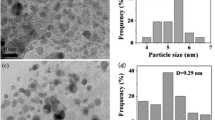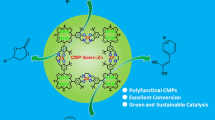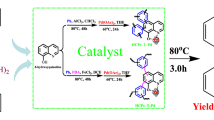Abstract
Four kinds of conjugated microporous polymers (CMPs) with imine structures were synthesized by a Sonogashira coupling reaction followed by a postreaction between aldehydes and amines. Palladium nanoparticles (Pd NPs) were successfully supported on the CMPs to prepare Pd/CMP heterogeneous catalysts and were used to catalyze the Suzuki–Miyaura coupling reaction. The number of aromatic nuclei and nitrogen atoms in the CMPs highly affects Pd loading. In the Suzuki–Miyaura coupling reaction, the Pd/CMP with good Pd NPs dispersibility and appropriate Pd content (Pd/CMP-NA) exhibited the highest catalytic efficiency with 100% conversion and 95.4% yield which can be used for many substrates. The Pd/CMP-NA heterogeneous catalyst was easy to recover and still exhibited good catalytic efficiency after 5 cycles. To further understand the catalytic mechanism of Pd/CMP-NA on the Suzuki–Miyaura coupling reaction, we proposed a rational catalytic cycle. This paper provides an idea for the structural design of CMPs used for Suzuki–Miyaura catalytic reaction.













Similar content being viewed by others
Data and code availability
Not applicable.
References
Kozuch S, Martin J (2011) What makes for a bad catalytic cycle? a theoretical study on the SuzukiMiyaura reaction within the energetic span model. ACS Catal 1:246–253. https://doi.org/10.1021/cs100129u
Miyaura N, Yamada K, Suzuki A (1979) A new stereospecific cross-coupling by the palladium-catalyzed reaction of 1-alkenylboranes with 1-alkenyl or 1-alkynyl halides. Org Lett 20:3437–3440. https://doi.org/10.1021/ol0102085
Jacquemin M, Hauwaert D, Debecker DP, Gaigneaux EM (2016) Influence of the acidity of oxidized Pd/silica-alumina catalysts on their performances in the Suzuki coupling. J Mol Catal A-Chem 416:47–55. https://doi.org/10.1016/j.molcata.2016.02.022
Chen Z, Yu X, Song Y (2016) Palladium nanoparticle supported on mesoporous polybenzimidazole as a heterogeneous catalyst for Suzuki cross-coupling reaction in aqueous media. Ferroelectrics 494:200–207. https://doi.org/10.1080/00150193.2016.1134037
Dong Y, Ju JJ, Li Y, Li WH, Chen YQ, Sun Q, Ma JP, Dong YB (2019) Nickel-metalated porous organic polymer for Suzuki–Miyaura cross-coupling reaction. RSC Adv 9:20266–20272. https://doi.org/10.1039/c9ra03679b
Kargar S, Elhamifar D (2020) Ionic liquid-containing polyethylene supported palladium: a green, highly efficient and stable catalyst for Suzuki reaction. Mater Today Chem 17:100318. https://doi.org/10.1016/j.mtchem.2020.100318
Chakraborty J, Nath I, Verpoort F (2019) Pd-nanoparticle decorated azobenzene based colloidal porous organic polymer for visible and natural sunlight induced Mott-Schottky junction mediated instantaneous Suzuki coupling. Chem Eng J 358:580–588. https://doi.org/10.1016/j.cej.2018.09.037
Ren XM, Kong SN, Shu QD, Shu MH (2016) Palladium nanoparticles supported on a porous organic polymer: an efficient catalyst for Suzuki–Miyaura and Sonogashira coupling reactions. Chin J Chem 34:373–380. https://doi.org/10.1016/j.cej.2018.09.037
Wang CA, Han YF, Li YW, Nie K, Cheng XL, Zhang JP (2016) Bipyridyl palladium embedded porous organic polymer as highly efficient and reusable heterogeneous catalyst for Suzuki–Miyaura coupling reaction. Rsc Adv 6:34866–34871. https://doi.org/10.1039/c6ra03331h
Wan YL, Song FX, Ye T, Li GX, Liu DF, Lei YZ (2019) Carbonylative Suzuki coupling and alkoxycarbonylation of aryl halides using palladium supported on phosphorus-doped porous organic polymer as an active and robust catalyst: carbonylative Suzuki coupling and alkoxycarbonylation of aryl halides. Appl Organomet Chem 33:e4714. https://doi.org/10.1002/aoc.4714
Song X, Li YX, Zhou L, Liu N, Wu ZQ (2022) Controlled synthesis of one-handed helical polymers carrying achiral organoiodine pendants for enantioselective synthesis of quaternary all-carbon stereogenic centers. Macromolecules 55:4441–4449. https://doi.org/10.1021/acs.macromol.2c00810
Liu N, Zhou L, Wu ZQ (2021) Alkyne-palladium(II)-catalyzed living polymerization of isocyanides: an exploration of diverse structures and functions. Acc Chem Res 54:3953–3967. https://doi.org/10.1021/acs.accounts.1c00489
Hou XH, Chen XJ, Gao X, Xu L, Zou H, Zhou L, Wu ZQ (2021) Synthesis of cyclic polyolefin: ring-opening metathesis polymerization by binuclear vanadium complexes†. Chin J Chem 39:1181–1187. https://doi.org/10.1002/cjoc.202000636
Zou H, Wu QL, Zhou L, Hou XH, Liu N, Wu ZQ (2021) Chiral recognition and resolution based on helical polymers. Chin J Polym Sci 39:1521–1527. https://doi.org/10.1007/s10118-021-2615-y
Wang C, Zou H, Liu N, Wu ZQ (2021) Recent advances in polyallenes: preparation, self-assembly, and stimuli-responsiveness. Chem Asian J 16:3864–3872. https://doi.org/10.1002/asia.202101051
Huang YB, Qiang W, Liang J, Wang X, Cao R (2016) Soluble metal-nanoparticle-decorated porous coordination polymers for the homogenization of heterogeneous catalysis. J Am Chem Soc 138:10104–10107. https://doi.org/10.1021/jacs.6b06185
Doherty S, Knight JG, Backhouse T, Abood E, Alshaikh H, Fairlamb I, Bourne RA, Chamberlain TW, Stones R (2017) Highly efficient aqueous phase chemoselective hydrogenation of α, β-unsaturated aldehydes catalysed by phosphine-decorated polymer immobilized IL-stabilized PdNPs. Green Chem 19:1635–1641. https://doi.org/10.1039/c6gc03528k
Gholinejad M, Zareh F, Najera C (2018) Iron oxide modified with pyridyl-triazole ligand for stabilization of gold nanoparticles: an efficient heterogeneous catalyst for A 3 coupling reaction in water: a new gold catalyst introduced in A3 coupling reaction in water. Appl Organomet Chem 32:e4454. https://doi.org/10.1002/aoc.4454
Hajipour AR, Sadeghi AR, Khorsandi Z (2018) Pd nanoparticles immobilized on magnetic chitosan as a novel reusable catalyst for green Heck and Suzuki cross-coupling reaction: in water at room temperature. Appl Organomet Chem 32:e4112. https://doi.org/10.1002/aoc.4112
Li LY, Zhao HX, Wang JY, Wang RH (2014) Facile fabrication of ultrafine palladium nanoparticles with size- and location-control in click-based porous organic polymers. ACS Nano 8:5352–5364. https://doi.org/10.1021/nn501853g
Debruyne M, Speybroeck VV, Voort P, Stevens CV (2021) Porous organic polymers as metal free heterogeneous organocatalysts. Green Chem 23:7361–7434. https://doi.org/10.1039/d1gc02319e
Rashidi S, Kashefi MH, Kim KC, Samimi-Abianeh O (2019) Potentials of porous materials for energy management in heat exchangers-A comprehensive review. Appl Energ 243:206–232. https://doi.org/10.1016/j.apenergy.2019.03.200
Fast CD, Woods J, Lentchner J, Makal TA (2019) Stabilizing defects in metal-organic frameworks: pendant lewis basic sites as capping agents in UiO-66-type MOFs toward highly stable and defective porous materials. Dalton T 48:14696–14704. https://doi.org/10.1039/c9dt03004b
Song K, Jiang Y, Zou Z (2020) Effect of vesicle structure on catalytic activity of Suzuki–Miyaura cross-coupling reaction: impact of framework and morphology. Chem Sel 5:11438–11445. https://doi.org/10.1002/slct.202003233
Yang D, Hou YL, Zhuang Q, Liu P, Kong J (2019) Nitrogen-rich porous organic polyamines for stabilization of highly dispersed metal nanoparticles and catalytic application. Macromol Rapid Comm 40:1900100-1–1900100-8. https://doi.org/10.1002/marc.201900100
Lin H, Gao X, Yao H, Luo Q, Xiang B, Liu C, Ouyang Y, Zhou N, Xiang D (2021) Immobilization of a Pd(II)-containing N-heterocyclic carbene ligand on porous organic polymers: efficient and recyclable catalysts for Suzuki-Miyaura reactions. Catal Sci Technol 11:3676–3680. https://doi.org/10.1039/d1cy00021g
Tao R, Ma XR, Wei XL, Jin YH, Qiu L, Zhang W (2020) Porous organic polymer material supported palladium nanoparticles. J Mater Chem A 8:17360–17391. https://doi.org/10.1039/d0ta05175f
Modak A, Ghosh A, Mankar AR, Pandey A, Selvaraj M, Pant KK, Chowdhury B, Bhaumik A (2021) Cross-linked porous polymers as heterogeneous organocatalysts for task-specific applications in biomass transformations, CO2 fixation, and asymmetric reactions. ACS Sustain Chem Eng 9:12431–12460. https://doi.org/10.1021/acssuschemeng.1c01537
Xu XH, Li YX, Zhou L, Liu N, Wu ZQ (2022) Precise fabrication of porous polymer frameworks using rigid polyisocyanides as building blocks: from structural regulation to efficient iodine capture†. Chem Sci 13:1111–1118. https://doi.org/10.1039/d1sc05361b
Wu K, Guo J (2015) Controllable synthesis of multi-scale conjugated microporous polymers. Acta Chim Sinica 73:480–486. https://doi.org/10.6023/A15020138
Tan LX, Tan B (2017) Hypercrosslinked porous polymer materials: design, synthesis, and applications. Chem Soc Rev 46:3481–3481. https://doi.org/10.1039/c7cs90027a
Lan S, Yang X, Shi KJ, Fan R, Ma D (2019) Pillarquinone-based porous polymer for a highly-efficient heterogeneous organometallic catalysis. Chem Cat Chem 11:2864–2869. https://doi.org/10.1002/cctc.201900516
Wang CA, Li YW, Hou XM, Han YF, Nie K, Zhang JP (2016) N-heterocyclic carbene-based microporous organic polymer supported palladium catalyst for Carbon–Carbon coupling reaction. Chem Sel 1:1371–1376. https://doi.org/10.1002/slct.201600174
Zhang Y, Zhang L, Zhang XL, Yang DD, Du C, Wan L, Au C, Chen J, Xie MJ (2020) Pyridine-based hypercrosslinked polymers as support materials for palladium photocatalysts and their application in Suzuki–Miyaura coupling reactions. New J Chem 44:15202–15208. https://doi.org/10.1039/d0nj01675f
Gao PW, Xiao YM, Dong ZH, Pan HG, Wang WT (2020) Facile synthesis of palladium nanoparticles supported on urea-based porous organic polymers and its catalytic properties in Suzuki–Miyaura coupling. J Saudi Chem Soc 24:282–287. https://doi.org/10.1016/j.jscs.2019.11.002
Lei YZ, Lan GS, Zhu DJ, Wang RS, Zhou XY, Li GX (2018) Urea-based amphiphilic porous organic polymer-supported palladium as a reusable catalyst for Suzuki–Miyaura coupling and hydroxycarbonylation reactions in water. Appl Organomet Chem 32:e4421. https://doi.org/10.1002/aoc.4421
Ding XS, Han BH (2015) Metallophthalocyanine-based conjugated microporous polymers as highly efficient photosensitizers for singlet oxygen generation. Angew Chem Int Edit 54:6536–6539. https://doi.org/10.1002/anie.201501732
Liu XM, Xu YH, Jiang DL (2012) Conjugated microporous polymers as molecular sensing devices: microporous architecture enables rapid response and enhances sensitivity in fluorescence-on and fluorescence-off sensing. J Am Chem Soc 134:8738–8741. https://doi.org/10.1021/ja303448r
Liras M, Iglesias M, Sánchez F (2016) Conjugated microporous polymers incorporating BODIPY moieties as light-emitting materials and recyclable visible-light photocatalysts. Macromolecules 49:1666–1673. https://doi.org/10.1021/acs.macromol.5b02511
Su C, Tandiana R, Tian B, Sengupta A, Tang W, Su J, Loh K (2016) Visible-light photocatalysis of aerobic oxidation reactions using carbazolic conjugated microporous polymers. ACS Catal 6:3594–3599. https://doi.org/10.1021/acscatal.6b00443
Dey SK, Dietrich D, Wegner S (2018) Palladium nanoparticle-immobilized porous polyurethane material for quick and efficient heterogeneous catalysis of Suzuki–Miyaura cross-coupling reaction at room temperature. Chem Sel 3:1365–1370. https://doi.org/10.1002/slct.201702083
Qing CG, Liu QL, Zhou WT, Hui GH, Guo Y (2017) Palladium nanoparticles supported on a carbazole functionalized mesoporous organic polymer: synthesis and their application as efficient catalysts for the Suzuki–Miyaura cross coupling reaction. Polym Chem-UK 8:1488–1494. https://doi.org/10.1039/c6py01784c
Arab P, Verlander A, El-Kaderi HM (2015) Synthesis of a highly porous bis (imino) pyridine-linked polymer and its postsynthetic modification with inorganic fluorinated ions for selective CO2 capture. J Phys Chem C 119:8174–8182. https://doi.org/10.1021/acs.jpcc.5b00690
Modak A, Pramanik M, Inagaki S, Bhaumik A (2014) A triazine functionalized porous organic polymer: excellent CO2 storage material and support for designing Pd nanocatalyst for C–C cross-coupling reactions. J Mater Chem A 2:11642–11650. https://doi.org/10.1039/c4ta02150a
Bhunia A, Vasylyeva V, Janiak C (2013) From a supramolecular tetranitrile to a porous covalent triazine-based framework with high gas uptake capacities. Chem Commun 49:3961–3963. https://doi.org/10.1039/c3cc41382a
Ju PY, Wu SJ, Su Q, Li XD, Liu ZQ, Li GH, Wu QL (2019) Salen-porphyrin-based conjugated microporous polymer supported Pd nanoparticles: highly efficient heterogeneous catalysts for aqueous C-C coupling reactions. J Mater Chem A 7:2660–2666. https://doi.org/10.1039/c8ta11330k
Liao YZ, Cheng ZH, Zuo WW, Thomas A, Faul C (2017) Nitrogen-rich conjugated microporous polymers: facile synthesis, efficient gas storage and heterogeneous catalysis. Acs Appl Mater Interfaces 9:38390–38400. https://doi.org/10.1021/acsami.7b09553
Lee J, Chang JY (2018) Synthesis of a palladium acetylide-based tubular microporous polymer monolith via a self-template approach: a potential precursor of supported palladium nanoparticles for heterogeneous catalysis. Rsc Adv 8:25277–25282. https://doi.org/10.1039/c8ra03275k
Chen J, Zhang J, Zhang Y, Xie MJ, Li T (2020) Nanoporous phenanthroline polymer locked Pd as highly efficient catalyst for Suzuki–Miyaura coupling reaction at room temperature. Appl Organomet Chem 34:e5310. https://doi.org/10.1002/aoc.5310
Xu L, Cui J, Gao S, Wang JJ, Liu J, Jia HG, Zhang ZF, Miao FJ, Zang Y (2022) Synthesis of Pd-stabilized chiral conjugated microporous polymer composites as high efficiency heterogeneous asymmetric henry reaction catalysts. Microporous Mesoporous Mat 341:112075. https://doi.org/10.1016/j.micromeso.2022.112075
Ratnam A, Bala M, Kumar R, Singh UP, Ghosh K (2017) Design and syntheses of a new family of palladium complexes derived from tridentate ligands and their application as catalysts for Suzuki-Miyaura cross-coupling reactions. J Organomet Chem 856:41–49. https://doi.org/10.1016/j.jorganchem.2017.12.017
Acknowledgements
This research was funded by the National Natural Science Foundation of China, grant number 52173202; the Heilongjiang Science Foundation Project, grants number YQ2022116;the Fundamental Research Funds in Heilongjiang Provincial universities (135309348).
Author information
Authors and Affiliations
Contributions
Y.Z. performed writing—review and editing. S.G. performed writing—original draft. B.J., H.S., J.W., J.L., and F.M. performed data curation. L.X. contributed to methodology and data curation.
Corresponding authors
Ethics declarations
Conflict of interest
The authors declare that they have no known competing financial interests or personal relationships that could have appeared to influence the work reported in this paper.
Ethical approval
Not applicable.
Additional information
Handling Editor: Maude Jimenez.
Publisher's Note
Springer Nature remains neutral with regard to jurisdictional claims in published maps and institutional affiliations.
Supplementary Information
Below is the link to the electronic supplementary material.
Rights and permissions
Springer Nature or its licensor (e.g. a society or other partner) holds exclusive rights to this article under a publishing agreement with the author(s) or other rightsholder(s); author self-archiving of the accepted manuscript version of this article is solely governed by the terms of such publishing agreement and applicable law.
About this article
Cite this article
Zang, Y., Gao, S., Jing, B. et al. Synthesis of Pd/conjugated microporous polymer heterogeneous catalysts via imine groups and high catalytic efficiency on Suzuki–Miyaura coupling reaction. J Mater Sci 58, 170–185 (2023). https://doi.org/10.1007/s10853-022-08032-8
Received:
Accepted:
Published:
Issue Date:
DOI: https://doi.org/10.1007/s10853-022-08032-8




